With summer winding down to a close, the disappearance of the lovely blooms can be disheartening, yet autumn is right around the corner! There are plenty of flowers that can be sewn in the fall that will brighten up your garden with the perfect shades for this new season. Choose any one of the flowers listed below to get your garden ready for autumn!
Let us slide into your dms 🥰
Get notified of top trending articles like this one every week! (we won't spam you)Pansies and Violas
Growth Difficulty: 5
Pansies and Violas are both biennial flowers, which means they have two cycles of growth in their lifetime. Violas are similar to Pansies but are a smaller flower. Both are perfect to plant during the fall because the soil is still warm enough for the base of the plants to take root.
This will cause the flowers to live through the winter and bloom once again when springtime rolls around! For the best results, use potting soil that has organic material mixed in. For instance, take a few grass clippings or leaves to put in the soil and your flowers will thank you!
These flowers do well in both full sun in addition to partly shaded areas. If you are worried about your plants during the winter months, add a nice layer of mulch around the base of the plants. This will keep the flower insulated and should help the plant make it through those cold temperatures.
When in bloom pansies will show off petals with warmer tones, such as reds, yellows, and oranges, while violas glow with colors of blue, purple, and white. With the mix of these flowers in your garden, it will be as if a rainbow has appeared in your own backyard!

Take the Quiz: Discover Your Ideal Stress-Relieving Hobby
Everyone deals with stress differently, and finding the right hobby can help you relax and unwind. Take this quiz to find out which stress-relievin...
Chrysanthemums
Growth Difficulty: 8
Typically, known as “mums” these perennial flowers can be a challenge to keep alive. To grow healthy these flowers need full sunlight and evenly moist soil. These flowers need lots of space to themselves and during the winter they do best in a shrub shelter where they will be protected from those frosty mornings.
Ideally, chrysanthemums should be planted six weeks before the first frost of winter, but even then some flowers do not make it through. While you can buy blooms, potted mums, from the store and replant them it is better to buy hardy mums online. Buying the flowers online will provide you with the proper information you need to produce the best blooms for your specific mum.
Most mums are a golden yellow color but can sometimes range in shade to bronze or burgundy. While they can be difficult to grow, chrysanthemums offer great uses. The petals of mums have been boiled and made into tea, which has been said to help patients with Influenza.
Many florists prefer these flowers due to the fact that they bloom for a longer period of time than most plants. Depending on the area you live in, different chrysanthemums will prosper. Be sure to look into the best type for your region!
Marigolds
Growth Difficulty: 4
As the name states, marigolds bring shades of gold and copper to your autumn garden. Even though they are planted in fall, marigolds can bloom all the way through summer if properly cared for! Plant your seedlings while the weather is still warm and your plants should sprout within a week.
These annual flowers are easy to grow but need a lot of sun. Planting these blooms in the shade will stunt their growth. Water marigolds at the base of the plant and only when their soil is dry, as over watering may drown your plant.
To get a bushier bloom, cut off dead blooms. This will encourage the flower to regrow. Certain marigolds such as the Calendula are edible and make a great addition to your salad.
In addition to its beauty, marigolds are a great companion plant to help keep nematodes off your vegetables. Make sure to add this easy flower to your garden and enjoy the many benefits of the marigolds!
Zinnia
Growth Difficulty: 2
Zinnias are a popular flower that can be spotted by their famous round, spherical petal formations. This annual plant comes in both vibrant colors and soft, pastel hues. A fairly inexpensive plant, these flowers are the perfect choice for someone on a budget!
In addition to being an economical choice, zinnias are favored among pollinators, such as butterflies. The best time to plant zinnias is six weeks before the first frost and in temperatures above fifty degrees Fahrenheit. Seedlings prosper when planted directly into a flower bed with several inches between each seed, allowing for air to circulate through the plants.
Zinnias are a tough flower and can bloom even poor soil and hard clays but benefit from slow-release fertilizer and frequent watering at the base of the plant. As the plants grow, they will need less water and need to be deadheaded. This means clipping the plant back and removing dead parts from the stalk.
By deadheading your zinnias, they will have more bountiful blooms. These flowers will bring birds of various kinds to your garden and provide your yard with beautiful blooms all season long. When the heads of the zinnia plant start to dry, collect the arrow-shaped seeds and save them to plant next year!
Celosia
Growth Difficulty: 4
This flower is quite a sight! As an annual bloom, celosia plants come in different shapes from plumes of petals to twisted crests, all of which add variety to your autumn garden. Although growing celosia can take a little more effort, these flowers draw attention to your lawn as well as to your dining room!
Celosia blooms are the ideal flower to dry and keep as a centerpiece for your table. This particular plant thrives in full sun and soil with a moderate amount of water. Be careful with your celosia, as the stems are easy to break.
As they grow, this flower will tend to hold onto dried blooms which can cause the entire stalk to dry. To prevent this from happening, ensure that all the dried blooms have been cut off, to preserve the stalk. Seeing that there are many types of celosia make sure to look into the size of the flower.
Some grow quite large and are used primarily as cut flowers in bouquets. These blooms will bring all those golden tones to your garden and make it as though you have your own personal sunset right in the backyard!
Astilbe
Growth Difficulty: 7
Is there a patch in your garden that is always shaded? Have no fear the astilbe plant is for you! This fern-like bloom thrives in shaded areas and will bring a little color to those areas that never see the sun.
Astilbes are a perennial flower with blooms that can range in height from six inches all the way up to five feet, depending on the variety you plant. They come in shades of red and white and will attract butterflies to your garden. When planting astilbe, make sure to leave three feet in between each seed and about four inches deep into the soil.
Water-logged soil will cause astilbe to suffer. Instead, make sure you the soil drains well and keep the dirt moist. Astilbe seeds can be hard to grow, as they are difficult to germinate.
Given this, if possible start your astilbe plant from another bloomed astilbe. This will ensure that your flower flourishes.
Bee Balm
Growth Difficulty: 6
Bee Balm, also known as wild bergamot, is a common perennial flower in North America. Although their petals may look spiky, that doesn't deter critters from coming around! As it's name states, this flower is popular with pollinators such as bees, butterflies, and even hummingbirds.
These blooms can be planted in the fall but need full sun exposure to really prosper. Plant these seeds about two feet apart to allow for air circulation around the stalks. Without enough circulation, powdery mildew can infect these flowers.
The soil around the base of each plant must be moist. To help with this many gardeners prefer to add mulch around the plants. After the first frost of fall hits, make sure to cut your bee balm to about two inches about the line of soil and deadhead any dried blooms.
This will cause the plant to bloom again in late summer. Bee balm blooms are quite fragrant since it is a part of the mint family and will cause your garden to smell heavenly. It's edible too!
Early colonists used to use bee balm petals to make salves and medicinal drinks. In this day and age, it is more commonly used in teas.
Ornamental Cabbage and Flowering Kale
Growth Difficulty: 6
Although this plant may have cabbage in its name, it is not edible! Ornamental cabbage and flowering kale fall under the same species category as edible cabbage but is not the same. These plants are bred specifically for their looks, which include shades purple, rose, and cream.
Despite the fact that they are technically a vegetable, each plant looks like a flower. Ornamental cabbage has large, flat leaves, while flowering kale has smaller, serrated leaves. Both are biennial plants but are usually treated as annuals because of foliage.
These blooms tend to draw more attention when they are planted together in large clusters. This allows the leaves to blend together and add diversity to your fall garden. If you plan to plant ornamental cabbage or flowering kale from seed, sow the seeds indoors ten weeks before the first frost, and then move the seedlings into your garden in the fall.
An already matured plant may be sown directly into the garden and the colors of the bloom will intensify as the season continues on. Cabbage and kale need full sun and rich soil that drains easily. Often water them keep the soil around the plants moist.
In areas that receive rain, watering your flowers will not be necessary. With this variety of flowers, your autumn garden will bloom until the snow comes down!
















